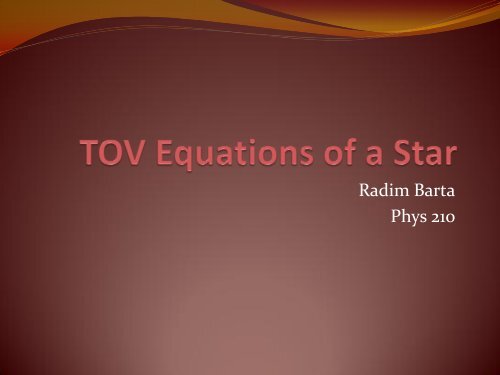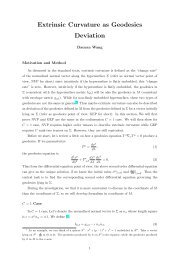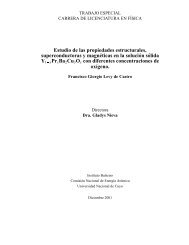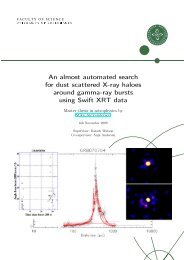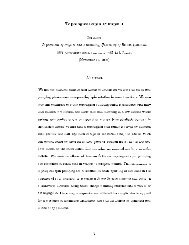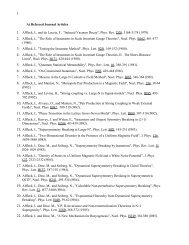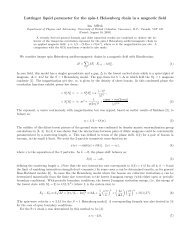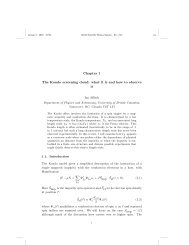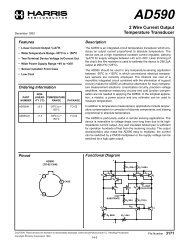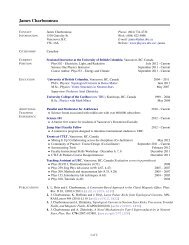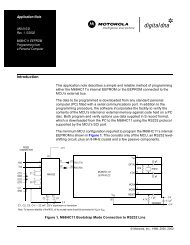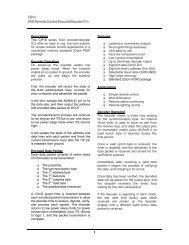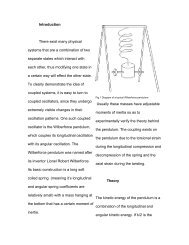Tolman-Oppenheimer-Volkoff Hydrostatic Equations Presentation
Tolman-Oppenheimer-Volkoff Hydrostatic Equations Presentation
Tolman-Oppenheimer-Volkoff Hydrostatic Equations Presentation
Create successful ePaper yourself
Turn your PDF publications into a flip-book with our unique Google optimized e-Paper software.
Radim Barta<br />
Phys 210
Purpose<br />
• Learn how the Runge-Kutta method works.<br />
• Write computer code for the Runge-Kutta method in<br />
Matlab (Octave) and Java<br />
• Integrate the <strong>Tolman</strong>-<strong>Oppenheimer</strong>-<strong>Volkoff</strong><br />
hydrostatic equations of a star.<br />
• Investigate how the equations are derived and look at<br />
how the state equation affects the integral.<br />
• Determine mass limits on different star types.
<strong>Tolman</strong>-<strong>Oppenheimer</strong>-<strong>Volkoff</strong> <strong>Equations</strong>
<strong>Tolman</strong>-<strong>Oppenheimer</strong>-<strong>Volkoff</strong> <strong>Equations</strong><br />
• Just some of the equations
<strong>Tolman</strong>-<strong>Oppenheimer</strong>-<strong>Volkoff</strong><br />
<strong>Equations</strong><br />
• After some equation manipulation we get the<br />
following equations, which we then integrate<br />
numerically.
Runge-Kutta Fourth Order Method<br />
x n+1 = x n + h<br />
• Most commonly used<br />
method for numerical<br />
integration<br />
• Part of a predictorcorrector<br />
group of<br />
algorithms.<br />
y n+1 = y n + (1/6)(k 1 + 2k 2 + 2k 3 + k 4 )<br />
where<br />
k 1 = h f(x n , y n )<br />
k 2 = h f(x n + h/2, y n + k 1 /2)<br />
k 3 = h f(x n + h/2, y n + k 2 /2)<br />
k 4 = h f(x n + h, y n + k 3 )
Computer Code<br />
• Matlab & Octave<br />
• Script writing<br />
• Matlab is a GUI<br />
• It can make plots<br />
• Has an extensive library<br />
• Octave doesn’t require<br />
access to hyper and runs<br />
faster<br />
while (p > 0)<br />
i = i+1;<br />
rho = rhonew;<br />
dm = dr*funmass(r,rho)<br />
m = m+dm<br />
k1 = dr*funpress(r, p, m, rho)<br />
k2 = dr*funpress(r+1/2*dr, p+1/2*k1, m, rho)<br />
k3 = dr*funpress(r+1/2*dr, p+1/2*k2, m, rho)<br />
k4 = dr*funpress(r+dr, p+k3, m, rho)<br />
pnew = p+1/6*k1+1/3*k2+1/3*k3+1/6*k4<br />
fprintf(fid,'1,,, %d,,, %f,,,<br />
%e,,, %e,,, %e,,,\n',i,r,pnew,rho,m);<br />
print(i,r,pnew,rho,m);<br />
rhonew = (pnew/C)^(1/lamda);<br />
r=r+dr;<br />
p=pnew;<br />
end;
Java<br />
• Why rewrite the program in Java?<br />
• I had Eclipse on my laptop<br />
• If written correctly the classes can be run on Linux OS<br />
and Windows<br />
• Since it is a compiled language it has the potentiel to run<br />
faster
Results
Results<br />
• The Runge-Kutta method worked well on the simple<br />
harmonic differential equations. Giving the sinusoidal<br />
curves for position and velocity with time.
What I still want to do:<br />
• Decipher what units the axis are in, and convert back<br />
to STI for comparison with real stars<br />
• Study more in depth how to choose proper state<br />
equations<br />
• And from this then be able to determine mass limits<br />
on different types of stars<br />
• Make my java program also create the plots


